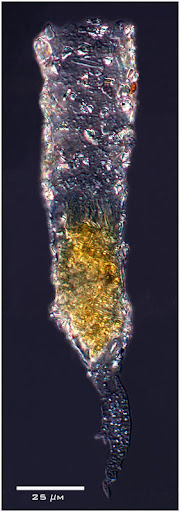
Rhizodomus tagatzi
Protozoans
Rhizodomus tagatzi is a comparatively large (0.13-0.20 mm) and distinctive tintinnid ciliate, which was first found in the Sea of Japan, Russia in 1933, and formally described in 1950. Tintinnids are free-swimming choreotrich ciliate protozoans which secrete a vase-shaped lorica formed of hardened proteins, which may be covered by fine particles. The animal can withdraw into the lorica when disturbed. The shape of the lorica is species-specific. While many ciliates preserve poorly, the loricae survive preservation in formalin, facilitating their ecological and biogeographic study, and formally described in 1950. It was later found in waters around central and southern Japan, South Korea, and northern China. In the 1960s, it was found to be widespread in northern Gulf of Mexico, and also found in the Caribbean, south of Cuba, and in the tropical West Atlantic, well offshore of Guyana and Brazil by the 1960s. Between 1994 and 2010, it was found in many locations in the Mediterranean Sea, including sites near the mouth of the Suez Canal, in Egypt, and lagoons in France, and Italy, used for shellfish aquaculture. This tintinnid has also been found in the Sea of Marmara, the Black Sea, and the North Sea. in 2002-2004, it was collected in Mission Bay, Callfornia (as Tintinnopsis corniger). Specimens of R. tagatzi were collected in ballast water from ships arriving in Coos Bay, Oregon, coming from Japan. Several records in Europe came from lagoons where Pacific Oysters (Magallana gigas) were cultured. Some tintinnids produce cysts, so transport with oysters or other shellfish is possible.